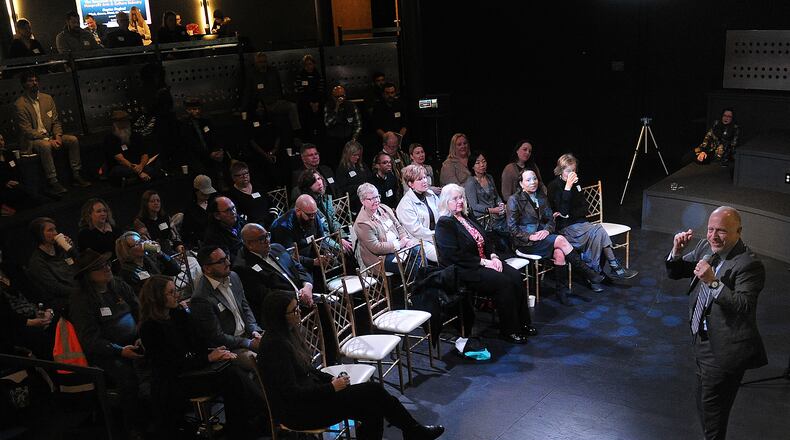Randy Cohen, vice president of research for Americans for the Arts, shared the results of the study, conducted from 2022 through early 2023. Notable findings included:
- Event-related spending by art and culture audiences totaled $142.5 million
- 4,490 local jobs are impacted by arts and culture
- Nonprofit arts and culture audiences spend an average of $21.60 per person, per event (not including ticket sales)
- 13,744 volunteers contributed to 397,000 hours, which accounts for $11.6 million in volunteer value
- 88.5 percent of audiences said “this activity or venue is inspiring a sense of pride in this neighborhood or community”
- 88.7 percent of audiences said “my attendance is my way of ensuring that this activity or venue is preserved for future generations”
“The arts are resilient and we are working our way back,” Cohen said. “The arts are about attracting people to the community. People want to participate, engage and scratch that cultural itch. They’re going to do it. They can do it right here in the (Dayton) community or do it somewhere else. So, if you’re a local business, you love this vibrant arts and culture community that we have in the Dayton region. There are so many cultural options, so many art forms, and so much to do.”
Culture Works joined 373 other communities across the United States and Puerto Rico in this endeavor and collected data in Montgomery, Miami, Clark and Greene counties. Data was from audience intercept surveys at events as well as collected from organizational surveys submitted by individual organizations or collected by Culture Works
There was a participation rate of 51.9 percent from individual organizations and a collected 1,187 audience intercept surveys.
“The data shows that investment in the nonprofit arts and culture industry builds the communities where people want to live and work,” said Dorie Watts, director of program operations and advocacy for Culture Works. “It is where entrepreneurs and creative economy businesses are launched and where nighttime economies flourish.
“When we prioritize diverse cultural expressions and traditions, it nurtures social connections, promotes community pride and identity, and boosts tourism by providing the authentic experiences that draw visitors to the community,” she said. “If visitors have a positive experience, it may become a place to work — and ultimately one in which to live. Creating livable communities is economic development.”
Michael R. Roediger, director and president of the Dayton Art Institute, also valued the study as a keen reminder of the importance of the arts.
“I appreciate that the Arts and Economic Prosperity 6 study results demonstrated what we in the arts have known for a long time and that is that the arts have a significant economic impact on the Dayton region, and directly influence an authentic urban experience of Dayton,” Roediger said. “The total economic impact of the Dayton Art Institute according to past studies is approximately $8 million a year. We need more corporations to invest in the arts that help them to attract outstanding talent and provide a wonderful quality of life. We hope that in the future there are taxes dedicated to the long-term care of our venues and arts organizations. The arts are not a luxury, they are business and an economic driver for our region.”
Democracy in the arts
In addition to stressing the importance of the arts in relation to economic viability, the meeting also spotlighted the arts in relation to preserving and strengthening democracy.
Sharon L. Davies, president and CEO of the Charles F. Kettering Foundation, viewed the study as a chance to “change a community’s understanding of the important impact of the arts which would justify more investments of a community in the arts.”
“Some people’s love languages are economic impact — economic development, economic prosperity,” Davies explained. “Our language at the Kettering Foundation has everything to do with the strength of democracy. And we see them as parts of the same conversation. We love that this has been a report that, nationally, has been developed by Americans for the Arts six times and that our community was involved in providing data that could show the robustness of the arts and culture community that exists here in Dayton.”
Davies praised Americans for the Arts for expanding its reach to ensure underserved populations were represented in the study.
“We’re thrilled that Americans for the Arts has realized they had to broaden their lens to capture the fullness of the arts and cultural community that exists here,” she said. “Because once we do that, there are all kinds of things that could happen not just economic impact and giving this community its due for its economic impact, but also thinking creatively about synergies in a community that are made possible by knowing where these assets actually exist.”
She also said being more strategic about utilizing the gifts of collaboration and partnerships between organizations is a primary means to improving community.
“When we have fuller idea of where those (artistic and cultural) assets are and get creative about partnerships, we can literally change the health of our communities,” Davies said. “This is what citizen engagement looks like.”
To read the study or for more information about Culture Works, visit cultureworks.org.
About the Author





